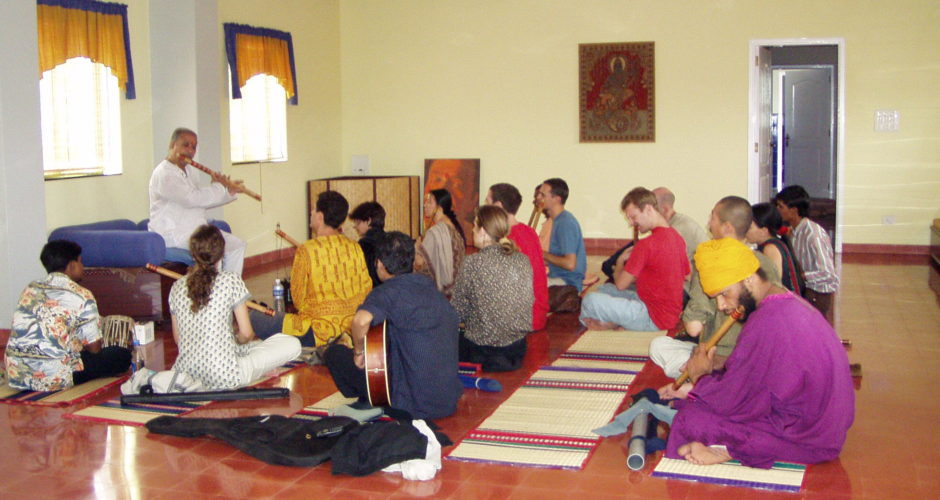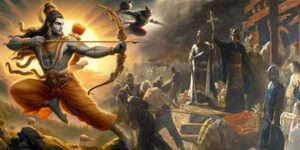East and west aren’t just directions in Girgaum’s Sicka Nagar. They are two vastly different educational concepts that reside in one building here.
Right behind The Modern School — whose students troop in to class in a black-white-and-red camouflage of pants and chequered skirts — hides a traditional school, whose 100 students turn up daily in colourful kurta-pyjamas, pagdis and chania cholis, armed with brass water bottles and steel tiffins.
These students of Gurukulam — which was founded by a bunch of diamond traders who were fed up with the formal education system — take off their fancy slippers outside, set their featherweight bags down, unlock their low benches, take out story books and sit in padmasana on the floor as their teacher plonks on a mattress-like cushion in front.
In this Gujarati-medium school, that teaches Vedic maths and Sanskrit, you will find no electronics,, no gas cylinders in the kitchen (only a coal stove), no plastic and no admission date notices (horoscopes are consulted before every admission).
Of course, the picture of this gurukul may be short of the textbook standard of a tree, a cow and a vast open space. Moreover, contrary to the traditional Guru-Shishya practice of imparting education where disciples live under the aegis of the guru, the students here don’t stay in the premises. However, for urban gurukuls — that have to preserve slands of tradition within a rabidly modern, concrete bubble like Mumbai — such concessions are inevitable. “It’s like doing a backstroke when everyone is swimming to the other side,” says Mittal Sanghvi, co-ordinator at Gurukulam, about her job.
Even as corporate caliphs are turning to ancient wisdom to navigate the future and seeking “pure knowledge” as a subsitute for competitive classroom curricula, gurukuls such as Nerul’s SIES Chandrasekarendra Saraswati Veda Vidya Pitha and Pandit Hariprasad Chaurasia’s Vrindaban Gurukul in Andheri are increasingly learning to not only master the backstroke but also evolve with the times. “Today, the gurukul stands the test of time,” says Rajeev Chaurasia, son of Pandit Hariprasad Chaurasia about Vrindaban gurukul which was launched in Mumbai in 2002. Here, as dictated by tradition, students live in the premises and “in the absence of the guru, the senior disciples who in their own right have begun successful professional careers, step in,” says Rajeev Chaurasia.
To keep pace with the times though, Vrindaban gurukul is not only thinking “brick and mortar” but also working on a digital plan, informs Rajeev Chaurasia. “While it is refurbishing its recording studio facility for students of music to listen and record, it is also drafting its plans for social outreach to schools, through a one-year long curriculum for school children and working professionals, through the initiative Dharohar,” he says. In addition, “through its initiative Sadhanalaya, it is sprucing up its digital archives of musical performances of Indian greats (both instrumental and vocal) from the last six decades,” he adds.
At Nerul’s SIES Ved Vidya Peth, on the other hand, its 23 resident male students straddle both worlds — the formal, English-speaking, uniform-clad world and the Sanskrit-veda-spouting, holy-ash-and-dhoti-toting world.
Unlike Girgaum’s Gurukulam whose students do not attend a formal school, the students here attend the nearby English-medium school. They begin their day with a cold shower at 4 am (to build resilience), attend Anushthan (daily worship ritual) at 5.30 am, drink “a glass of Bournvita” served along with breakfast and on returning, sit for Veda class before attending tuitions.
Over time, this gurukul has introduced concessions for students appearing for board exams. “We reduce the Veda portion that year and give them a month’s extension to prepare for the oral Veda exams,” says the ever-smiling principal Sunder Sharma, seated under a tree in the nippy temple complex.
Besides academic tweaks, the tug-of-war between tradition and modernity also calls for gastronomic changes. For instance, after teachers started calling him up to complain about the lack of variety in his students’ “short-break tiffins”, Sharma introduced “sandwiches, chappatis and jam” in the predominantly Tamil pantry.
Of course, peer pressure can be a tough nemesis. “Sometimes, kids see their friends wearing modern clothes and want to mimic them,” says Sanghvi of Gurukulam. Then, there are other social temptations. “To beat the drudgery of routine, we also take students out for films with social themes and take students IPL cricket matches at DY Patil stadium,” says Sharma. Last year, in fact, when three students here scored above 85 per cent in SSC, “we gave them a cellphone each,” reveals Sharma.
While the students of SIES Ved pathshala have gone on to work with corporates such as TCS and Wipro (they take up religious assignments on weekends), the boys to pass out of Gurukulam are now astrologers and diamond traders. For parents, it is the promise of life skills and extra-curricular activities that make gurukuls a big draw. Silky Doshi, whose daughters — Ashvi, Kavya and Sowmya — attend Gurukulam, isn’t too worried about job prospects. “My kids can pursue careers in rare subjects such as Sanskrit,” says Doshi, who does not want her wards to be mere cogs in the corporate machine.
Times of India






























